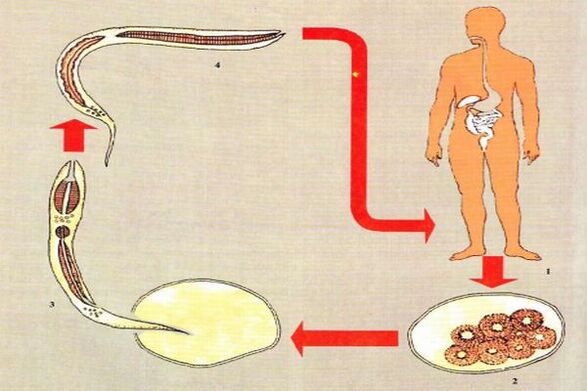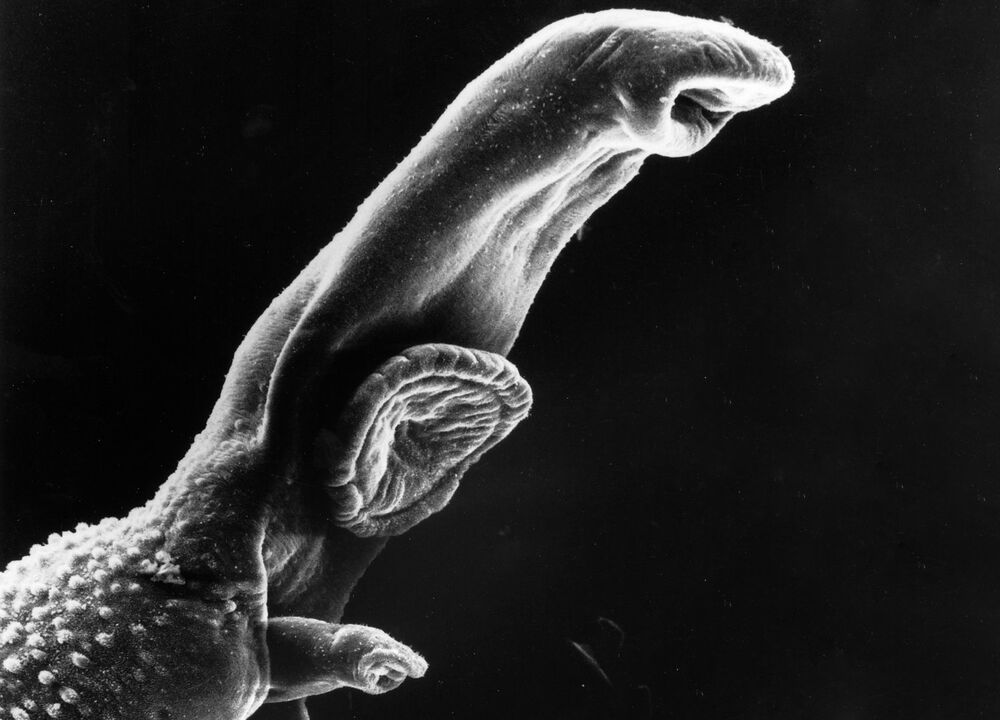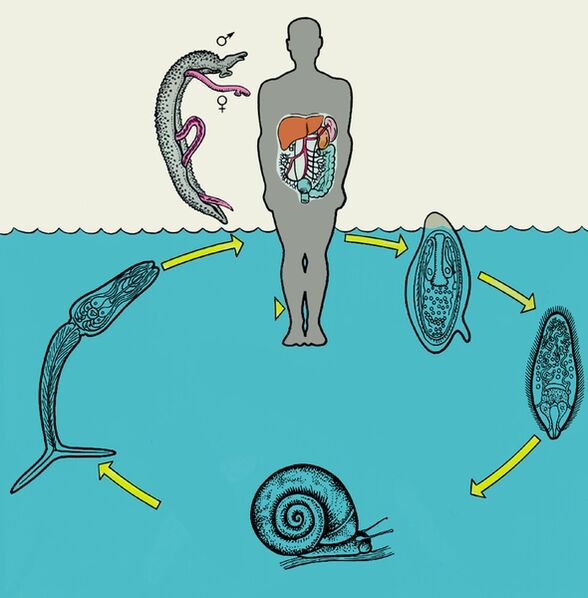Life cycle- this is the totality of all stages of development "from egg to egg", and in the absence of an egg, from any stage to the closest similar. The main biological aspects of the life of any organism are adaptations that ensure the preservation of the individual and the species.
In parasites (unlike free-living animals), nutrition is provided continuously, and therefore the reproductive activity of the organism increases. The increased reproduction due to the spatial and temporal limitation of the habitat of the parasite leads to the rapid overpopulation of this place and, accordingly, the need for translocation for the protection of the species.
The totality of all stages of a parasite's ontogeny and the way it passes from one mother to another is called its life cycle.
Forms of periods
After learning that parasites are organisms that use other living things to develop, it is important to understand what options are available for the development of life. According to the classification, there are simple and complex cycles. The first occurs without a change of owner. Examples of this are roundworms, amoeba, whipworms, etc. A complex group includes several hosts at the same time. These are vertebrates, fish, crustaceans, etc. can be. An example of this is helminths.
The development cycle of whipworms does not require an intermediate host.
Once inside the final host, the parasites grow and reproduce. Depending on the type of pathogen, the larvae can either stay inside or leave the body. In most cases, excretion occurs through the intestines. This allows you to determine the type of pathogen through simple tests.
Features of cyclic stages
Each stage of development has its own characteristics. Even the treatment is determined only on the basis of this factor. This is explained, for example, by the fact that not all drugs work on larvae, while it is easier to get rid of adult parasites.
The intermediate and final carrier of the parasite depends on the type of helminthosis.
With that said, let's see how the development cycle continues:
- Dispersal - this cycle exists when an intermediate host that is the source but not the final stage is currently considered the only option, i. e. there is no potential final host. In such a case, the intermediate host is used for further development and nutrition.
- Active growth - after reaching the most suitable conditions, the parasite stops, corrects itself in the presence of suitable facilities and begins to grow to the sexual adult state.
- Migration to another habitat - after an adult individual reproduces eggs, in most cases they move to further development. They can be distributed in different ways. Parasites often migrate through the digestive tract with the food mass. There are also those that, due to their size, easily penetrate the blood and spread throughout the body.
- Asexual reproduction - some types of parasites differ in that they do not require a second partner for reproduction. The most striking example is the tapeworm, in which each strobila has a uterus that reproduces mature eggs.

Important Concepts
The first thing to emphasize when familiarizing with parasites is the concept of "host". It is an organism in which the development and reproduction of parasites takes place. "Intermediate host" is selected separately. In this case, the pathogen remains inside the body until it has the opportunity to migrate to the most favorable environment provided by the final host.
A cycle can occur with 1-4 host changes. In this case, the first is intermediate, and the rest are additional. Parasites enter the final host through direct contact or through an intermediate host. Development and sexual reproduction take place here.
Development of the parasite begins when it enters the final host.
There are also concepts such as reservoir parasitism and host-feeder. In the first case, we are talking about a situation where a parasite that has reached suitable conditions can remain unchanged for a long time, waiting for a more favorable solution.
Provider-owneris an organism used only as food. The simplest option is pliers. By studying how these types of parasites feed, we can understand that they need human blood to exist, but they do not stay in or on the human body for long.
The concept of "parasite reservoir" or "reservoir owner" is also distinguished. It is a host in whose body the pathogen can live for a long time, accumulate, multiply and spread to the surrounding areas.
Biology of parasites
Parasite carriage is considered separately - in the case of pathogenic parasites living in the human body, but the development of the disease does not occur. But such a person poses a danger to others.
The parasite and its host affect each other.
Harmful effects of the parasite on the host:
- Mechanic;
- Toxic;
- Refusal to eat;
- Violation of tissue integrity.
Accordingly, the body of the host "responds" to the effect of the parasite.
Infections caused by parasites can be divided according to the sensitivity of the pathogen to the host:
- Anthroponotic - humans act as hosts;
- Zoonotic - various animals act as hosts;
- Anthropozoonous diseases are invasive and infectious diseases common to humans and animals.
Medical parasitology consists of 3 main divisions:
- Protozoan parasites - protozoology.
- Parasitic worms, helminths - helminthology.
- Arthropods - arachnology.

Life cycle stages
In most cases, protozoa have specialized stages adapted to carry out the transition from one host to another. These stages are called propagation.
In intestinal parasitesstages of promotionusually adapted to experience in a foreign environment. Most intestinal protozoa form cysts covered with a dense membrane. When the cysts of a number of species (Entamoeba histolytica, E. coli, Lamblia intestinalis, etc. ) mature, several successive divisions of the nucleus occur.
After hitting an adultmultinucleated cystIn the new host, the cytoplasm divides to form several individuals. Cysts are normally provided with a nutrient supply that is consumed during the ripening process and when the cyst remains in the external environment. The reproductive stage of coccidia is a membrane-enclosed fertilized female germ cell (oocyst).
Most parasitic protozoavertebrate tissue and blood are transferred from one mother to another using a vector. In this case, the propagative stages are localized in the blood or in the outer membrane of vertebrates. Trypanosoma cruzi, the causative agent of Chagas disease, multiplies in the leishmania stage in the cells of internal organs. The leishmanial forms of the parasite transform into trypanosomes that penetrate the blood but do not reproduce there.
Transmission of infectionThe vector occurs through a blood-sucking insect. Leishmama donovani, the causative agent of Indian visceral leishmaniasis (kala-azar), multiplies in histophagocytic cells of tissues that are poorly accessible to the vector. But at a late stage of the process, late leishmanoid - a lesion containing a large number of leishmania - can form on the skin of the patient. In some cases, leishmania is present in the blood with this disease. The proliferative stages of malaria parasites are gamonts circulating in the blood of the host.
Along withstages of promotionin the life cycle of tissue parasitesinvasive stages, adapted to penetrate the vertebrate host. Thus, the development of representatives of the genus Trypanosoma in the vector ends with the formation of metacyclic trypanosomes that no longer reproduce in the vector and are adapted for the development of a vertebrate host.

The invasive stages of malaria parasites are sporozoites.
Groups of helminths
Each type of helminth develops only under certain conditions. Depending on the conditions of development, parasitic worms are divided into two large groups:biohelminthsAndgeohelminths.
Biohelminths
To whombiohelminthsThese include parasites that develop with the participation of two or more organisms. Adult forms of worms live in one organism, larval stages live in the other.
It is called the organism in which the adult forms are parasitized and sexual reproduction takes placefinal(or definitive) owner.
It is the organism in which larval forms developIntermediatethe ownerFor example, an adult bovine tapeworm is a parasite in the human intestine, and the development of its larvae occurs in the body of cattle.
Thus, for this tapeworm, humans are the definitive host and cows are the intermediate host.
Biohelminths include most representatives of the flatworm species.
Geohelminths
Geohelminthsare parasites that do not require a change of host during development. Their eggs are thrown from the body with feces into the external environment, and larvae develop in them at a certain temperature and humidity.
Such an egg with a larva becomes infectious. Once in the human body (in its intestines), the larvae break free from the egg shell, penetrate certain organs and take on a sexually mature form. In some helminths, the larva hatches in the external environment. Such a larva lives in water or soil, goes through certain stages of development and then actively penetrates the body through the skin.






































